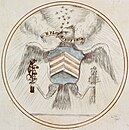First Continental Congress
 From Wikipedia - Reading time: 13 min
From Wikipedia - Reading time: 13 min
First Continental Congress | |
|---|---|
 | |
| Type | |
| Type | |
| History | |
| Established | September 5, 1774 |
| Disbanded | October 26, 1774 |
| Preceded by | Stamp Act Congress |
| Succeeded by | Second Continental Congress |
| Leadership | |
President | |
Secretary | |
| Seats | 56 from 12 of the 13 colonies |
| Meeting place | |
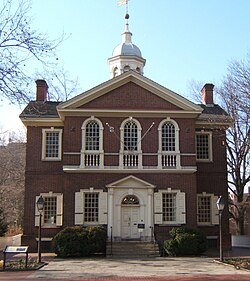 | |
| Carpenters' Hall in Philadelphia | |
The First Continental Congress was a meeting of delegates of twelve of the Thirteen Colonies held from September 5 to October 26, 1774, at Carpenters' Hall in Philadelphia at the beginning of the American Revolution. The meeting was organized by the delegates after the British Navy implemented a blockade of Boston Harbor and the Parliament of Great Britain passed the punitive Intolerable Acts in response to the Boston Tea Party.[1]
During the opening weeks of the Congress, the delegates conducted a spirited discussion about how the colonies could collectively respond to the British government's coercive actions, and they worked to make a common cause. As a prelude to its decisions, the Congress's first action was the adoption of the Suffolk Resolves, a measure drawn up by several counties in Massachusetts that included a declaration of grievances, called for a trade boycott of British goods, and urged each colony to set up and train its own militia. A less radical plan was then proposed to create a Union of Great Britain and the Colonies, but the delegates tabled the measure and later struck it from the record of their proceedings.
The First Continental Congress agreed on a Declaration and Resolves that included the Continental Association, a proposal for an embargo on British trade. They also drew up a Petition to the King pleading for redress of their grievances and repeal of the Intolerable Acts. That appeal was unsuccessful, leading delegates from the colonies to convene the Second Continental Congress, also held in Philadelphia, the following May, shortly after the Battles of Lexington and Concord, to organize the defense of the colonies as the American Revolutionary War.
Convention
[edit]The Congress met from September 5 to October 26, 1774, in Carpenters' Hall in Philadelphia with delegates from 12 of the Thirteen Colonies participating. The delegates were elected by the people of the respective colonies, the colonial legislature, or by the Committee of Correspondence of a colony.[2] Loyalist sentiments outweighed Patriot views in Georgia, leading that colony to not immediately join the revolutionary cause until the following year when it sent delegates to the Second Continental Congress.[3]
Peyton Randolph was elected as president of the Congress on the opening day, and he served through October 22 when ill health forced him to retire, and Henry Middleton was elected in his place for the balance of the session. Charles Thomson, leader of the Philadelphia Committee of Correspondence, was selected as the congressional secretary.[4] The rules adopted by the delegates were designed to guard the equality of participants and to promote free-flowing debate.[2]
As the deliberations progressed, it became clear that those in attendance were not of one mind concerning why they were there. Conservatives such as Joseph Galloway, John Dickinson, John Jay, and Edward Rutledge believed their task to be forging policies to pressure Parliament to rescind its unreasonable acts. Their ultimate goal was to develop a reasonable solution to the difficulties and bring about reconciliation between the Colonies and Great Britain. Others such as Patrick Henry, Roger Sherman, Samuel Adams, and John Adams believed their task to be developing a decisive statement of the rights and liberties of the Colonies. Their ultimate goal was to end what they felt to be the abuses of parliamentary authority and to retain their rights, which had been guaranteed under Colonial charters and the English constitution.[5]
Roger Sherman denied the legislative authority of Parliament, and Patrick Henry believed that the Congress needed to develop a completely new system of government, independent from Great Britain, for the existing Colonial governments were already dissolved.[6] In contrast to these ideas, Joseph Galloway put forward a "Plan of Union" which suggested that an American legislative body should be formed with some authority, whose consent would be required for imperial measures.[6][7]
Declaration and Resolves
[edit]In the end, the voices of compromise carried the day. Rather than calling for independence, the First Continental Congress passed and signed the Continental Association in its Declaration and Resolves, which called for a boycott of British goods to take effect in December 1774. After Congress signed on October 20, 1774, embracing non exportation they also planned nonimportation of slaves beginning December 1, which would have abolished the slave trade in the United States of America 33 years before it actually ended.[8]
Accomplishments
[edit]The primary accomplishment of the First Continental Congress was a compact among the colonies to boycott British goods beginning on December 1, 1774, unless parliament should rescind the Intolerable Acts.[9] While delegates convened in the First Continental Congress, fifty-one women in Edenton, North Carolina formed their own association (now referred to as the Edenton Tea Party) in response to the Intolerable Acts that focused on producing goods for the colonies.[10] Additionally, Great Britain's colonies in the West Indies were threatened with a boycott unless they agreed to non-importation of British goods.[11] Imports from Britain dropped by 97 percent in 1775, compared with the previous year.[9] Committees of observation and inspection were to be formed in each Colony to ensure compliance with the boycott. It was further agreed that if the Intolerable Acts were not repealed, the colonies would also cease exports to Britain after September 10, 1775.[9]
The Houses of Assembly of each participating colony approved the proceedings of the Congress, with the exception of New York.[12] The boycott was successfully implemented, but its potential for altering British colonial policy was cut off by the outbreak of hostilities in April 1775.
Congress also voted to meet again the following year if their grievances were not addressed satisfactorily. Anticipating that there would be cause to convene a second congress, delegates resolved to send letters of invitation to those colonies that had not joined them in Philadelphia, including Quebec, Saint John's Island (now Prince Edward Island), Nova Scotia, Georgia, East Florida, and West Florida.[13] Of these, only Georgia would ultimately send delegates to the next Congress.
List of delegates
[edit]Gallery
[edit]
|
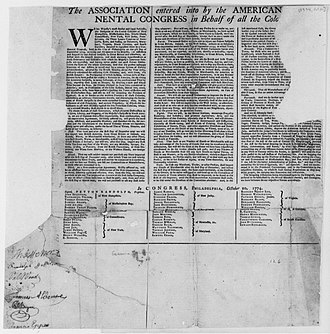
|
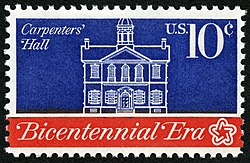
|
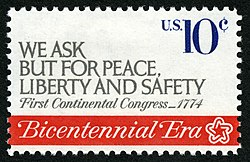
|
200th anniversary of the First Continental Congress
commemorated on two 10-cent U.S. postage stamps of the 1971–1983 Bicentennial Series | |

|
Signatory page of the three-page Continental Association
signed by 53 of the 56 delegates |
See also
[edit]- American Revolutionary War#Prelude to revolution
- Founding Fathers of the United States
- List of delegates to the Continental Congress
- Journals of the Continental Congress
Explanatory notes
[edit]- ^ a b Future U.S. president.[14]
- ^ a b c d e Appointed by the Committee of Fifty-one of the city and county of New York and authorized by the counties of Albany, Duchess, and Westchester.
- ^ For Suffolk County.
- ^ a b Appointed by the general meeting of all the committees of Orange County.
- ^ a b Future U.S. Supreme Court chief justice.[14]
- ^ a b Ultimately became a loyalist.
- ^ a b Served as president of the Congress.
Citations
[edit]- ^ Stathis, Stephen (2014). Landmark Legislation 1774–2012: Major U.S. Acts and Treaties. Washington DC: CQ Press. pp. 1–2. doi:10.4135/9781452292281.n1. ISBN 978-1-4522-9230-4.
- ^ a b c "First Continental Congress: Proceedings of the First Continental Congress". ushistory.org. Philadelphia, Pennsylvania: Independence Hall Association. Retrieved April 30, 2019.
- ^ Cashin, Edward J. (March 26, 2005). "Revolutionary War in Georgia". New Georgia Encyclopedia. Georgia Humanities and the University of Georgia Press. Retrieved April 30, 2019.
- ^ Risjord, Norman K. (2002). Jefferson's America, 1760–1815. Rowman & Littlefield. p. 114.
- ^ McLaughlin, Andrew C. (1936). "A constitutional History of the United States". New York, London: D. Appleton-Century Company. pp. 83–90. Retrieved August 27, 2014.
- ^ a b Greene, Evarts Boutell (1922). The Foundations of American Nationality. American Book Company. p. 434.
- ^ Miller, Marion Mills (1913). Great Debates in American Hist: From the Debates in the British Parliament on the Colonial Stamp. Current Literature Pub. Co. p. 91.
- ^ Lynd, Staughton; Waldstreicher, David (2011). "Free Trade, Sovereignty, and Slavery: Toward an Economic Interpretation of American Independence" (pdf). The William and Mary Quarterly. 68 (4): 597–630. doi:10.5309/willmaryquar.68.4.0597. ISSN 0043-5597.
- ^ a b c Thomas Paine (1982). Isaac Kramnick (ed.). Common Sense. Penguin Classics. p. 21.
- ^ Barbara Oberg, ed. (2019). Women in the American Revolution: gender, politics, and the domestic world. Charlottesville: University of Virginia Press. ISBN 978-0-8139-4260-5. OCLC 1091235010.
- ^ Ketchum, p. 262.
- ^ Launitz-Schurer p. 144.
- ^ Frothingham, Richard (1872). The Rise of the Republic of the United States. Boston, Massachusetts: Little, Brown, and Company. pp. 375–376. Retrieved April 30, 2019.
- ^ a b "Continental Congress". A&E Television Networks. October 3, 2018 [Originally published February 4, 2010]. Retrieved April 30, 2019.
General and cited references
[edit]- Bancroft, George. History of the United States of America, from the discovery of the American continent. (1854–78), vol 4–10 online edition
- Burnett, Edmund C. (1975) [1941]. The Continental Congress. Greenwood Publishing. ISBN 0-8371-8386-3.
- Henderson, H. James (2002) [1974]. Party Politics in the Continental Congress. Rowman & Littlefield. ISBN 0-8191-6525-5.
- Launitz-Schurer, Loyal Whigs and Revolutionaries, The making of the revolution in New York, 1765-1776, 1980, ISBN 0-8147-4994-1
- Ketchum, Richard, Divided Loyalties, How the American Revolution came to New York, 2002, ISBN 0-8050-6120-7
- Miller, John C. Origins of the American Revolution (1943) online edition Archived May 25, 2012, at the Wayback Machine
- Puls, Mark, Samuel Adams, father of the American Revolution, 2006, ISBN 1-4039-7582-5
- Montross, Lynn (1970) [1950]. The Reluctant Rebels; the Story of the Continental Congress, 1774–1789. Barnes & Noble. ISBN 0-389-03973-X.
- Peter Force, ed. American Archives, 9 vol 1837–1853, major compilation of documents 1774–1776. online edition
External links
[edit]| This article is part of a series on the |
| United States Continental Congress |
|---|
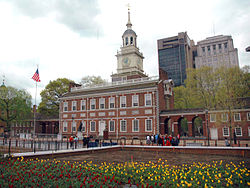 |
| Predecessors |
| First Continental Congress |
| Second Continental Congress |
| Congress of the Confederation |
| Members |
| Related |
|
|
 KSF
KSF

